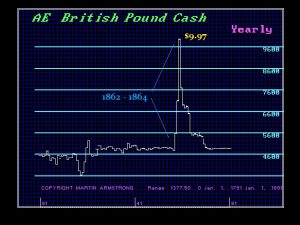Imagine if the world’s metre sticks all grew or shrunk a bit each year. That would make for a confusing system of weights and measures, wouldn’t it? Well, that is exactly what happens with money.
We have been measuring the world around us for thousands of years. Units like feet and cubits have been used for distances, pounds and kilograms to measure weight, and dollars and yen to measure economic value. Measuring value, however, is by far the most complicated of the measurements that must be taken. This is because – unlike the other units – the various items that have been used to represent dollars and yen are constantly fluctuating in value.
The British Pound, or lb
Monetary units have always been closely tied up with units of weight. For instance, the word “pound” has been used to describe both the British monetary unit (£) and the weight (lb). The pound weight was originally based on wheat. In 1266, King Henry III decreed that the British unit referred to as the grain should be defined as the weight of a corn of wheat “well dried, and gathered out of the middle of the ear.” Thirty-two grains were to be equal to a pennyweight, twenty pennyweights equal to an ounce, and twelve ounces added up to a pound. So the early English pound, otherwise known as the Tower pound, was comprised of 7,680 “well-dried” grains from the middle of an ear of wheat.

The Tower pound wasn’t the only pound weight used in England. The Troy pound, used for gold and silver, contained 5,760 grains, while the Merchant pound was made up of 6,750 grains. To add to the confusion, the avoirdupois pound would contain 7,000 grains.
The Exchequer Standard
Although the grain unit served as the basis for weights, people didn’t go about their regular business of measuring the weights of things by counterbalancing them against tiny grains of wheat. Imagine how awkward it would be to go to the local market to ask for an ounce of meat! The butcher would have had to count out 640 grains and then counterbalance them on a scale against the hunk of meat, an arduous process that would have brought the gears of trade to a near halt. Buyers would have been constantly accusing sellers of not using appropriately dry grains, adding to the confusion.
…click on the above link to read the rest of the article…







